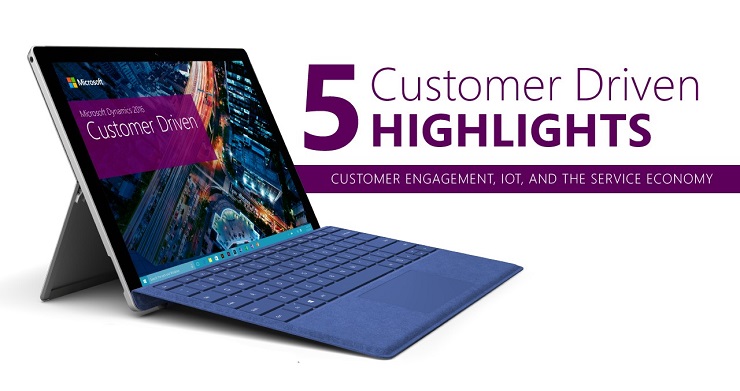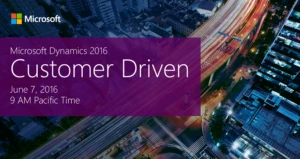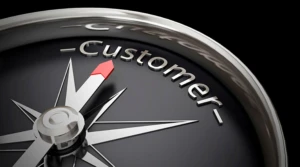
Top 5 Takeaways from Customer Driven
On June 7, Microsoft hosted Customer Driven, a virtual event examining the changing technology landscape and the impact of digital transformation on customer engagement in the new service economy.
Speakers Scott Guthrie (Executive Vice President, Microsoft Cloud and Enterprise Group), Jujhar Singh (General Manager, Microsoft Dynamics CRM), Paul Greenberg (Managing Principal, The 56 Group; author, CRM at the Speed of Light), and Nick Farrant (Senior Vice President, Rolls-Royce) shared insights, stories, and tips, while Sven Haynes (Director of IT, Blendtec) and Paul Spruiell (Vice President of Operations, NAVCO) sat down for a pair of enlightening interviews.
These conversations delivered a clear message: organizations that embrace digital transformation will be empowered to engage customers in deeper and more effective ways. Here are five key takeaways for any business that wants to run an intelligent, 21st-century organization.
Want to dig deeper on what the experts had to say?
1. Digital services are transforming customer engagement
“In many ways, the progression of customer engagement is a reflection of technology’s ever-increasing presence in our society. Access to digital services is redefining our opportunity to reach customers at an even deeper level.” —Scott Guthrie
Look no further than your own digital life and it’s clear that apps, devices, social media, modern POS systems, and Internet of Things (IoT) devices empower you to connect with your favorite brands in any way you desire. In this connected world, business doors are open to you 24/7.
Just look at the numbers:
-
2 billion active social media accounts
-
2.4 billion smart devices by 2018
-
3 billion active Internet users
-
80 billion connected IoT devices by 2025
For businesses that embrace digital transformation, this evolution presents a tremendous opportunity. While technology becomes more innovative, predictive, and accessible, it enables companies to create more responsive, personalized experiences than ever before.
2. Every employee can and should be more empowered
“Empower your employees: behind every amazing customer experience are employees who deliver them.” —Jujhar Singh
Equipping sales, marketing, and service organizations, including mobile resources, with a unified CRM technology is essential to next-generation intelligent customer engagement. When employees have the right tools, resources, and information at their fingertips, they are not only more productive, but are also empowered to deliver exceptional customer experiences—and inspire brand loyalty in return. Every customer-facing resource should have the information and guidance they need to serve their customers according to their unique needs and preferences.
Find out how successful companies are empowering employees through intelligent service technology
3. The Internet of Things cannot be ignored
“We’re excited about the predictive nature of the data we can get from IoT.” —Paul Spruiell, NAVCO
The business world has long anticipated the promise of how IoT technology will revolutionize customer service. This is no longer a dream; the intersection of IoT with core business strategies is a reality that many companies are leveraging with remarkable success. While greater numbers of smart, connected products are produced and deployed in multiple industries, the ability to transform the explosion of data from these devices will lead to even better products and customer experiences.
For NAVCO—the largest privately held security integrator in the US and emerging thought leader in the area of IoT—that could mean predicting hard drive failures and opening new revenue streams. As Paul Spruiell predicts, “We’re going to go to your location and fix something you didn’t know was broken.”
Blendtec, which designs and manufactures “the last blender you’ll ever need,” is equally bullish on the power of IoT. “The personalization of our devices is very important to us,” says Sven Haynes. “Right now, we have some gamification … but where we really want to go is to connect that blender to the Internet of Things.” He imagines a blender that helps you crowd-source recipes, get nutritional data, give the company feedback, and more.
4. Customer experience will eclipse product and price
“If you think that there’s been a business revolution over the last decade plus, you’re wrong. What we’ve had is a digital communications revolution, which has transformed not only how we communicate … but also the expectations of that communication and whom we trust. It’s also transformed how we create, distribute, and consume information. It has impacted every single institution on the planet.” —Paul Greenberg
To purchase or to walk away? In sales interactions, the customer has always had complete control. Yet the factors motivating those sales decisions today are far different from the motivators of even 10 years ago. Traditionally, products and services were sold separately. Employees did most of the work. And the sale took place in one transactional moment through one human interaction.
Today, 86 percent of customers will pay more for a better customer experience. In fact, customer experience is expected to overtake product and price as the key brand differentiator. In today’s service economy, businesses sell services, experiences, and outcomes in addition to products. This has transformed stand-alone transactional experiences into lifetime customer relationships, which translates into greater brand loyalty and higher lifetime value.
Go beyond videos and download bonus materials for Customer Driven
5. Customer engagement is an ongoing commitment
“Customer engagement is the ongoing interactions between company and customer, offered by the company, chosen by the customer.” —Paul Greenberg
When we talk about building loyalty, advocacy, and lasting relationships, customer engagement sure sounds like a marriage. But true customer engagement isn’t determined by the amount of time and effort a customer makes; it’s not unidirectional. It’s something altogether different because engagement levels vary from moment to moment, from casual to intense, and from infrequent to frequent.
And here’s why you should care about engaging your customers: fully engaged customers spend more and continue spending. When compared to average consumers, fully engaged customers represent a 23 percent premium of wallet share, profitability, and revenue. The flip side is just as striking: disengaged customers spend 13 percent less than an average consumer.
The takeaway: customers want to feel valued. They want you to know who they are. They want you to give them convenient options and products and experiences that prove you understand their behaviors and needs.
To thrive in the new service economy, organizations must leverage all the technology, data, and innovation available—and provide customers with nothing less than the personalized, proactive and predictive experiences they demand and deserve.
Experience Customer Driven as if you were there



